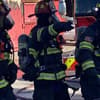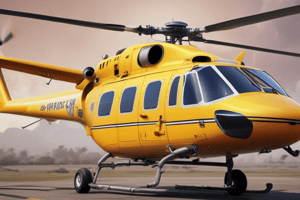Podcast
Questions and Answers
What is a primary advantage of air medical transport?
What is a primary advantage of air medical transport?
- Increasing transport time for distant hospitals
- Providing advanced care and specialized resources (correct)
- Reducing the cost of patient transport
- Increasing the number of responders
When should the decision to use air medical transport be made?
When should the decision to use air medical transport be made?
- After patient stabilization
- During patient transport
- After ground transport has been attempted
- Early on in patient treatment (correct)
What is a limitation of rotor wing helicopters in air medical transport?
What is a limitation of rotor wing helicopters in air medical transport?
- Cabin size limitations affecting patient size (correct)
- Long distance transport capabilities
- Speed and efficiency
- Ability to transport multiple patients
What should be considered when deciding to use air medical transport?
What should be considered when deciding to use air medical transport?
What should be done before requesting air medical transport?
What should be done before requesting air medical transport?
What should be avoided when establishing a landing zone?
What should be avoided when establishing a landing zone?
Why should patients in cardiac arrest or with per-arrest conditions not be transported by air?
Why should patients in cardiac arrest or with per-arrest conditions not be transported by air?
What should be done during a night landing?
What should be done during a night landing?
What should be done at a hazardous materials incident?
What should be done at a hazardous materials incident?
What should be done when approaching the helicopter?
What should be done when approaching the helicopter?
Flashcards are hidden until you start studying
Study Notes
Air Medical Transport
- Air medical transport can speed up patient transfer to definitive care, especially for trauma or medical calls
- Factors to consider when deciding to use air medical transport:
- Patient condition and risk of transport
- Time savings
- Resources brought to the patient (e.g., RSI, blood products)
Types of Aircraft
- Rotor Wing helicopters: most frequently used for air medical transport
- Fixed Wing aircraft: used for longer distance transports
- Examples of air medical transport services:
- Duke's rotor Wing helicopters
- Fixed Wing service in the upstate
Advantages of Air Medical Transport
- Helps patients receive definitive care within recommended time frame
- Reduces transport time for distant hospitals
- Can provide advanced care and specialized resources
- Decision to use air medical transport should be made early on in patient treatment
Pre-Flight Considerations
- Pre-flight check must be done
- Personnel and gear must be loaded
- Scene landing zone must be established
- Patient must be transferred to the air medical transport crew
Disadvantages of Air Medical Transport
- Patients in cardiac arrest or with per-arrest conditions may not be suitable for air transport due to space limitations
- Weather and terrain can limit or prevent air transport
- Altitude and air speed limitations apply
- Cabin size limitations affect patient size and number of patients transported
- Cost is a factor
- Patient condition may restrict air transport
- Limited number of responders and potential for crash
When to Call for Air Medical Transport
- Patients with time-dependent injuries or illnesses (e.g., trauma, strokes, diving accidents)
- Patients requiring advanced care or specialized resources (e.g., blood products, limb replantation, burn centers)
- Patients who would benefit from quick transport to definitive care
Requesting Air Medical Transport
- Request must be made through dispatch
- Dispatch may ask for patient weight due to helicopter weight limits
- Ground crew may access flight crew on radio frequency
- Factors to consider before requesting air medical transport:
- Weather
- Environmental terrain
- Altitude
- Air speed limitations
- Cabin size limitations
- Cost
Establishing a Landing Zone
- Responsibility of the EMS crew, often with fire and police partners
- Landing zone should be:
- A hard or cropped grassy level surface
- At least 60 x 60 ft (100 x 100 ft recommended)
- Clear of loose debris and overhead hazards
- Marked with weighted cones or emergency vehicles with headlights facing inward
- Do not use accident tape, people, or flares to mark the area
- Essential personnel only should be present
Safety Considerations
- Be familiar with air medical transport capabilities, protocols, and methods
- Approach the helicopter from the front, between 10:00 and 2:00 positions
- Walk in a crouch position and never approach the helicopter from the rear
- Keep the pilot in view at all times and approach/depart from the front
- Keep a safe distance from the aircraft when it's on the ground
- Never approach the tail of the rotor or vehicle near the tail rotor
- Familiarize yourself with hand signals used by the flight crew
Night Landings and Hazardous Materials Incidents
- Do not shine spotlights or flashlights in the air
- Direct lights towards the ground instead
- Approach the aircraft from the downhill side only on uneven ground
- Do not move the patient to the helicopter until signaled by the flight crew
- Notify the flight crew immediately if it's a Hazmat scene
- Establish the landing zone upwind and uphill from the scene
- Decontaminate patients exposed to hazardous materials before loading into the aircraft
Air Medical Transport
- Speeds up patient transfer to definitive care, especially for trauma or medical calls
- Factors to consider when deciding to use air medical transport:
- Patient condition and risk of transport
- Time savings
- Resources brought to the patient (e.g., RSI, blood products)
Types of Aircraft
- Rotor Wing helicopters: most frequently used for air medical transport
- Fixed Wing aircraft: used for longer distance transports
- Examples of air medical transport services:
- Duke's rotor Wing helicopters
- Fixed Wing service in the upstate
Advantages of Air Medical Transport
- Helps patients receive definitive care within recommended time frame
- Reduces transport time for distant hospitals
- Can provide advanced care and specialized resources
- Decision to use air medical transport should be made early on in patient treatment
Pre-Flight Considerations
- Pre-flight check must be done
- Personnel and gear must be loaded
- Scene landing zone must be established
- Patient must be transferred to the air medical transport crew
Disadvantages of Air Medical Transport
- Patients in cardiac arrest or with per-arrest conditions may not be suitable for air transport
- Weather and terrain can limit or prevent air transport
- Altitude and air speed limitations apply
- Cabin size limitations affect patient size and number of patients transported
- Cost is a factor
- Patient condition may restrict air transport
- Limited number of responders and potential for crash
When to Call for Air Medical Transport
- Patients with time-dependent injuries or illnesses (e.g., trauma, strokes, diving accidents)
- Patients requiring advanced care or specialized resources (e.g., blood products, limb replantation, burn centers)
- Patients who would benefit from quick transport to definitive care
Requesting Air Medical Transport
- Request must be made through dispatch
- Dispatch may ask for patient weight due to helicopter weight limits
- Ground crew may access flight crew on radio frequency
- Factors to consider before requesting air medical transport:
- Weather
- Environmental terrain
- Altitude
- Air speed limitations
- Cabin size limitations
- Cost
Establishing a Landing Zone
- Responsibility of the EMS crew, often with fire and police partners
- Landing zone should be:
- A hard or cropped grassy level surface
- At least 60 x 60 ft (100 x 100 ft recommended)
- Clear of loose debris and overhead hazards
- Marked with weighted cones or emergency vehicles with headlights facing inward
- Do not use accident tape, people, or flares to mark the area
Safety Considerations
- Be familiar with air medical transport capabilities, protocols, and methods
- Approach the helicopter from the front, between 10:00 and 2:00 positions
- Walk in a crouch position and never approach the helicopter from the rear
- Keep the pilot in view at all times and approach/depart from the front
- Keep a safe distance from the aircraft when it's on the ground
- Never approach the tail of the rotor or vehicle near the tail rotor
- Familiarize yourself with hand signals used by the flight crew
Night Landings and Hazardous Materials Incidents
- Do not shine spotlights or flashlights in the air
- Direct lights towards the ground instead
- Approach the aircraft from the downhill side only on uneven ground
- Do not move the patient to the helicopter until signaled by the flight crew
- Notify the flight crew immediately if it's a Hazmat scene
- Establish the landing zone upwind and uphill from the scene
- Decontaminate patients exposed to hazardous materials before loading into the aircraft
Studying That Suits You
Use AI to generate personalized quizzes and flashcards to suit your learning preferences.





